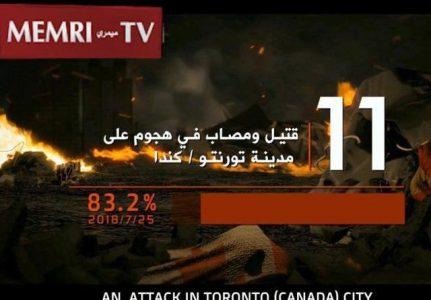
ISIL propaganda video calls Toronto shooting its top foreign operation
A propaganda video released by pro-Islamic State media praising terrorist attacks abroad names July’s mass shooting on Toronto’s Danforth Avenue as its most successful foreign operation of the year.
This is the third claim connecting the deadly Canadian attack to the Islamic State of Iraq and the Levant, but there is still no evidence from ISIL or its media affiliates that the gunman acted on behalf of any organizations.
The video, released Sunday by the pro-ISIL media outlet Al-Abd Al-Faqir Media Foundation, mimics a corporate year-end review of operations, although it is filled with factual mistakes.
It gives the Toronto attack an 83.2-per-cent success rating, claiming it caused 11 casualties.
It is unclear how the rating or casualty figures are calculated, as the July 22 incident had a higher toll, according to police: two people were killed — Reese Fallon, 18, and Julianna Kozis, 10 — and 15 others were injured. Gunman Faisal Hussain killed himself with his gun afterwards. The video says the attack was on July 25, three days after it occurred.
After the initial claim by ISIL, Toronto Police Chief Mark Saunders said the investigation has uncovered “no evidence to support these claims” and multiple terrorism experts cautioned against accepting the ISIL claim at face value.
A request for comment from Toronto police on the new claim went unanswered prior to deadline.
The 2:47-long video clip is titled “Harvest of the Lone Lions” and features excerpts from the most recent speech by Abu Bakr Al-Baghdadi, the leader of ISIL, also known as ISIS, in which he praises attackers in the West, according to a translation by the Middle East Media Research Institute (MEMRI). There is background singing on a similar theme.
The information on the Toronto attack includes imagery taken from mainstream media after the shooting, including Prime Minister Justin Trudeau speaking to the media. The rating and casualty information is superimposed over an animated scene of a tattered Canadian flag in a burning urban landscape.
The video also hails these attacks from 2018:
• An Aug. 23 knife attack in Trappes, France, a suburb of Paris, during which two people were killed and a third was injured. ISIL gives that incident a 16.7-per-cent rating.
• A May 29 attack in Liège, Belgium, during which a prisoner on temporary release killed two police officers and a civilian and injured four other officers before being killed. ISIL gives this attack a 20.9-per-cent rating and claims only six casualties. It also wrongly gives the date of the attack as July 25. (Apparently, the ISIL media machine forgot to change the date of its operational reports after mistyping the Toronto date).
• A May 4 incident in Russia’s Nizhny Novgorod, in which security forces killed a person they called an ISIL militant during a shootout that apparently injured three others. That attack was given a 16.7-per-cent rating for three casualties, but wrongly said it occurred on July 25.
Included in the video is a fictional scene of London’s Westminster Abbey exploding, taken from the 2016 Hollywood movie London Has Fallen.
The rating of attacks appears virtually random and doesn’t correspond to any verified data, nor does the video offer any additional evidence of a pre-existing link between the gunman and ISIL, a researcher with MEMRI’s Jihad and Terrorism Threat Monitor group told the National Post.
It was only after Western news reports raised the possibility of a jihadi link that an ISIL-controlled media outlet, Amaq News Agency, first claimed responsibility for the Toronto carnage. A day later, ISIL’s Al Naba weekly newsletter commended the Toronto gunman and threatened more attacks, according to MEMRI. The attack was called “a link in a chain of operations against the countries sponsoring the Crusader’s alliance against ISIS.”
Al-Abd Al-Faqir distributed the new video using Telegram, an encrypted internet messaging service. It follows a recent trend of ISIL releasing stylized videos purporting to report statistics and communiqués on its activities to supporters.
“Al-Abd Al-Faqir Media Foundation has released several such video montages in the past and regularly publishes pro-ISIS audio-visual material, mainly focusing on threatening the West,” MEMRI said.
ISIL was once careful about the attacks it claimed. Researchers found their claims typically credible and came with verification, often showing an attacker giving a pledge of support on video or offering details promptly after attacks took place, terrorism experts said.
As ISIL’s control has waned in the past year or so, communication links have been broken and its messaging seems more desperate and less reliable. Claims of responsibility have been issued for attacks that grabbed headlines but were devoid of tangible links to the terrorist organization.
The hugely devastating 2017 Las Vegas shooting that left 58 people dead and 851 injured, for instance, was claimed by ISIL but no evidence supports that conclusion and the FBI said the attack has no link to international terrorism.
Source: nationalpost





